This python project aims to build, analyze, benchmark, and run a delta neutral farming strategy on UniswapV2 and similar forks.
For several months now, UniswapV2 forks have been multiplying, promising liquidity providers increasingly large APYs. Would it be possible to take advantage of these high APYs, without taking risks?
In this document, I will focus on USD/token pools. The idea is to benefit from liquidity provider APYs while being delta neutral, that is not being exposed to the market.
So having provided a unit of liquidity (= 1 USDT/Stablecoin + the equivalent of 1 USD in the form of another token T), how can we be delta neutral? The first idea is to short 1 USD of T. But as a liquidity provider, our exposure to the market depends on the price of the underlying asset T.
Indeed, with
We can solve for
Thus, by shorting the non-constant amount
We enter the pool a time
By closing the short position, we find ourselves in the same context as when we started, and can reiterate. This strategy is indeed market neutral, and while not losing money due to market exposure we are able to collect pool fees and funding rate fees if positive (which is often the case on crypto assets!)
To benchmark this strategy, I implemented it in python (pool.py). It is possible to use two types of benchmarking: a benchmark on mathematically generated prices, and a benchmark on real historical data. Price variation at each time step are modelized by a normal distribution with a set standard deviation (the "volatility"). To run a simulation on generated prices, one must create a Portfolio object with the value of APR and funding rates by time step to be benchmark, with mode=0. Then one must call simulation() method of the PF object with the number of time step, and how often should the short position be rebalanced. For the historical data simulation, one must first gather the prices data using getPriceHistorical() with currency, start date and end date as parameters before using it on the creation of the PF object with mode=1 this time.
mode=2 is used for an actual implementation of this strategy in real time using Binance API. NOTE: API changed, the functions of the bot need to be re implemented in bot.py
Please see examples at the end of pool.py.
After playing with the parameters (I won't do a statistical analysis of their impact), we notice that the most important parameter is the volatility of the underlying asset. It is understandable because volatility directly impact the validity of our infinitesimal calculus - costing us a non negligeable amount of money.
With a "low" crypto daily volatility (average daily movement = 4.5%, which is still high for cryptos) we obtain great results (pool APR = 20%, funding rates APR = 8%)
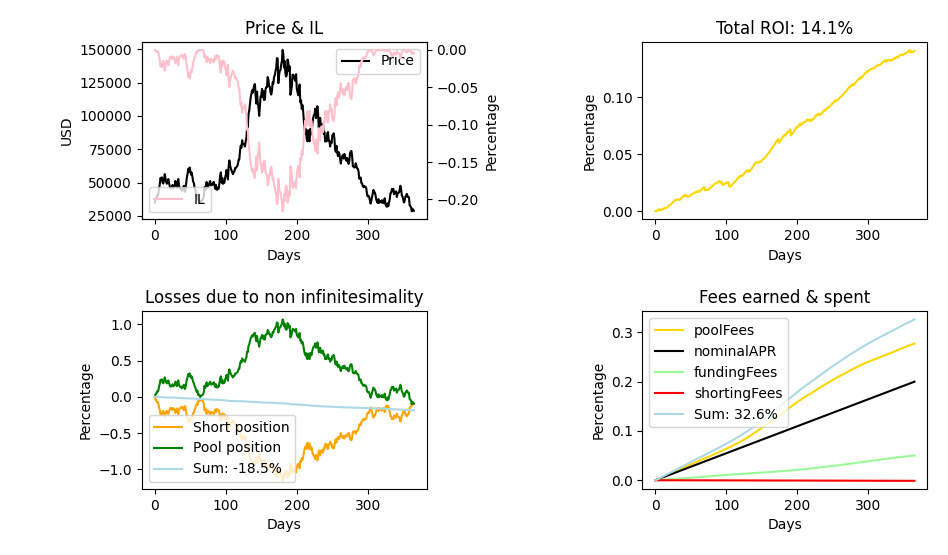 IL in pink is the Impermanent loss, in % (loss linked to providing liquidity in the pool VS just holding). Here, with close to no IL, rebalancing the short cost us only 18.5% which is greatly under our benefits (20% nominal but more due to positive IL during the period, to 32%). So we obtain a great ROI YoY. Bottom left graph shows what it costs us to be market neutral. As we can see, the two lines are somewhat symmetric and it shows that our short position indeed counter balance our pool position (not perfectly due to dP not being enoughly small): market neutrality. Note: the cost of being market neutral is higher when price goes in an upward trend because our short position is "lagging" in a way that makes us lose money, but it's counter balanced by poolFees increasing due to our pool position increasing. It's the opposite when the trend is downward: it costs less to be market neutral, but pool fees are lower.
IL in pink is the Impermanent loss, in % (loss linked to providing liquidity in the pool VS just holding). Here, with close to no IL, rebalancing the short cost us only 18.5% which is greatly under our benefits (20% nominal but more due to positive IL during the period, to 32%). So we obtain a great ROI YoY. Bottom left graph shows what it costs us to be market neutral. As we can see, the two lines are somewhat symmetric and it shows that our short position indeed counter balance our pool position (not perfectly due to dP not being enoughly small): market neutrality. Note: the cost of being market neutral is higher when price goes in an upward trend because our short position is "lagging" in a way that makes us lose money, but it's counter balanced by poolFees increasing due to our pool position increasing. It's the opposite when the trend is downward: it costs less to be market neutral, but pool fees are lower.
This result holds with a higher IL showing that the strategy doesn't rely on any market conditions:
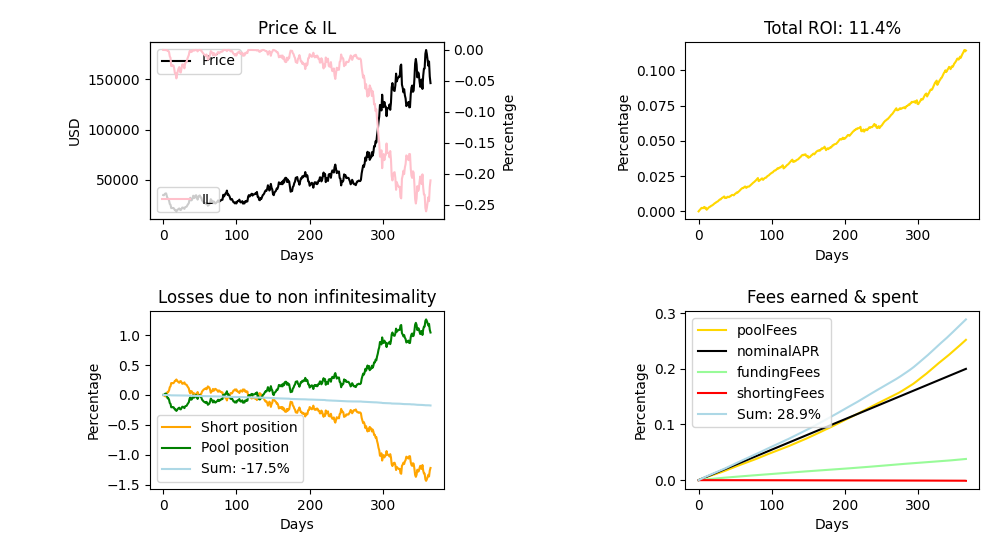
As said, if the volatility of the underlying asset increases (average daily movement = 7% which is very high), the strategy becomes unprofitable. The relative error of our calculus become too important to be absorbed by the profits:
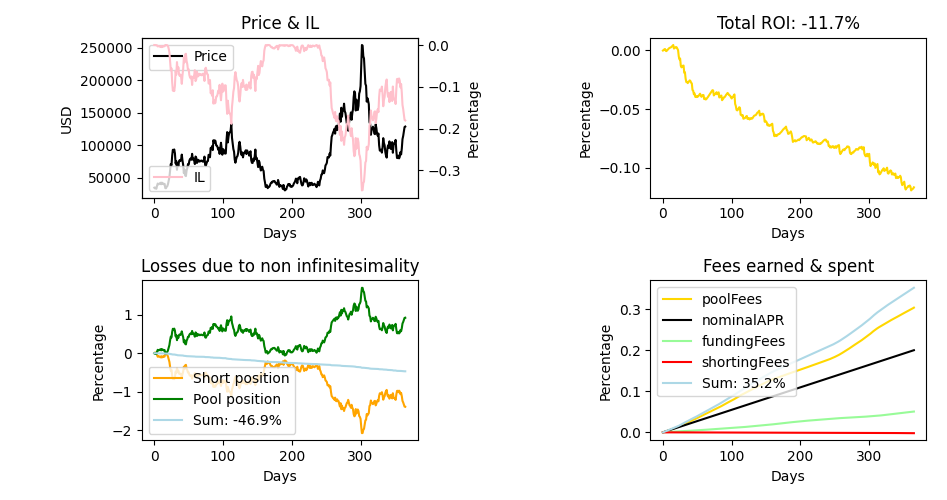
We will try to confirm those observations against reality.
First, let's benchmark the startegy on a relative low-volatility crypto asset such as BTC on the 8 first months of 2022 with the same APR (pool & funding rates):
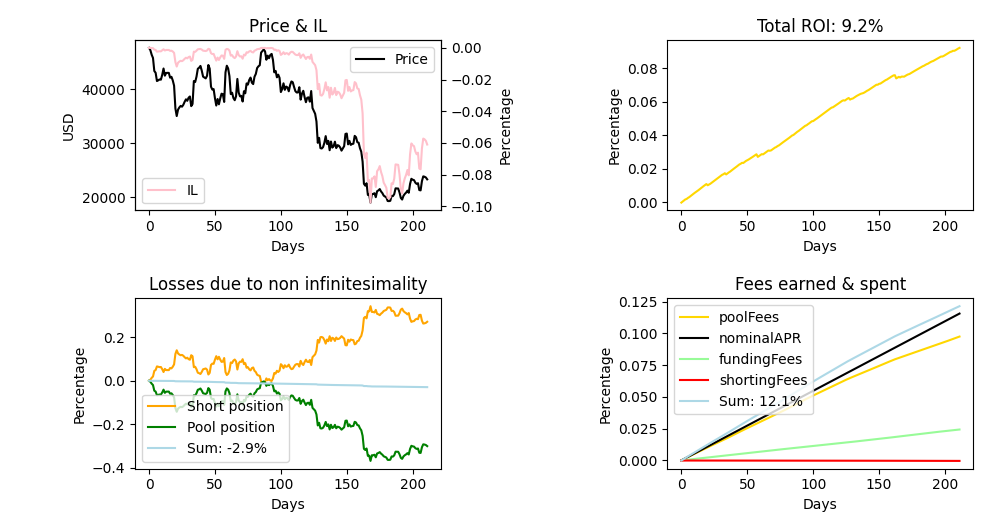 9.2% ROI an 8 month which is around 14% YoY. This is extremely satisfying but we need to take in consideration that finding a 20% APR pool on BTC/USDC might be really specific/hard. Moreover, the APR of a pool is varying during the year. Note: I made this program in march and tested BTC ROI for the 2 first month of 2022 (around 2.1%). This benchmark is thus really fair and works on real market conditions, even during a big krash.
9.2% ROI an 8 month which is around 14% YoY. This is extremely satisfying but we need to take in consideration that finding a 20% APR pool on BTC/USDC might be really specific/hard. Moreover, the APR of a pool is varying during the year. Note: I made this program in march and tested BTC ROI for the 2 first month of 2022 (around 2.1%). This benchmark is thus really fair and works on real market conditions, even during a big krash.
What about a more volatile asset such as AVAX?
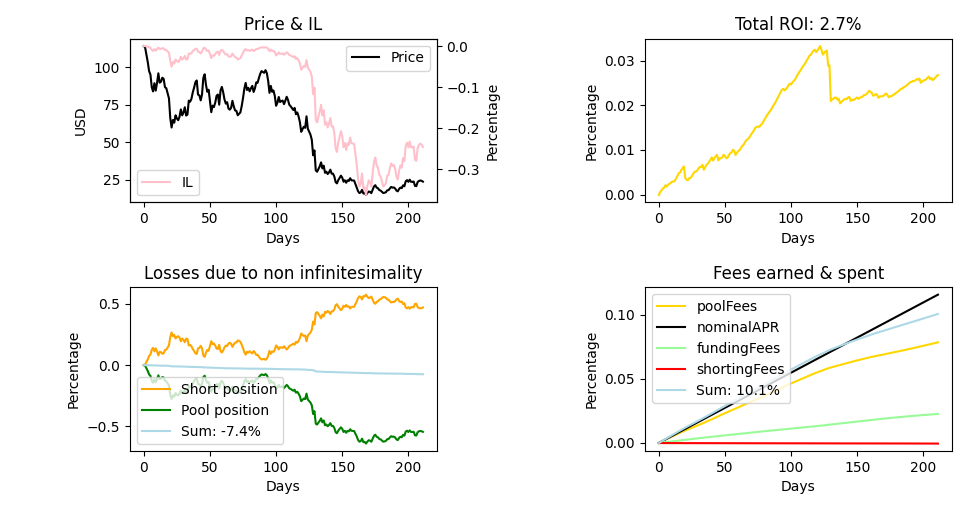 It is still profitable!
It is still profitable!
This strategy proves to be profitable. We need to find an asset highly traded to have great pool APRs, with a small dilution so it's not too shorted and funding rates are positive (and interesting), and which is not too volatile. We could try to benchmark a list of asset using real APRs data from Uniswap/TraderJoe for example - which was not done here.
Finally we may focus on token/token pools. There might be interesting positively correlated pairs where the pools is thus less exposed to market movements and so volatility matters less. Furthermore, having two shorts implies the earning of two funding rates fees.